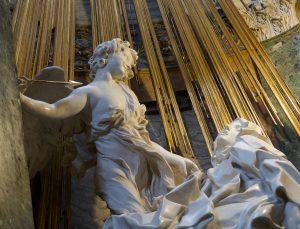
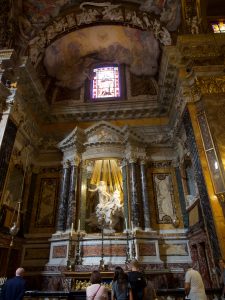
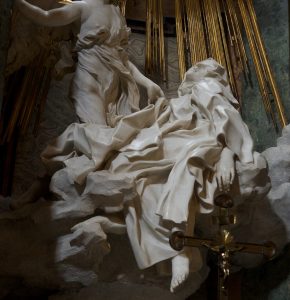
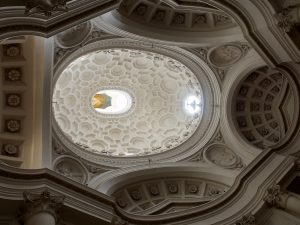
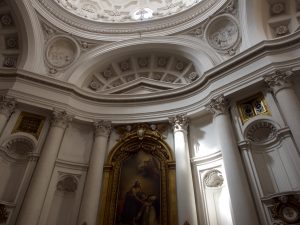
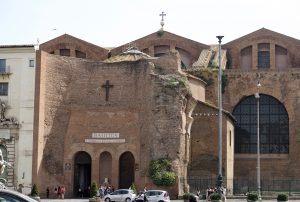
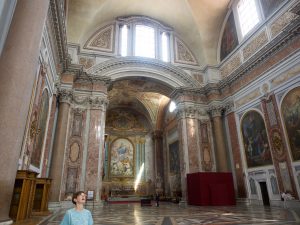
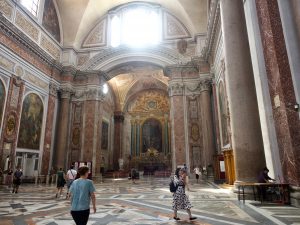
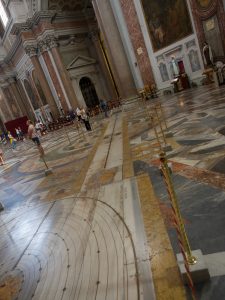
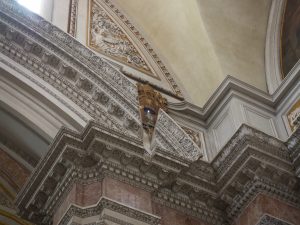
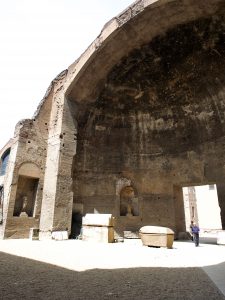
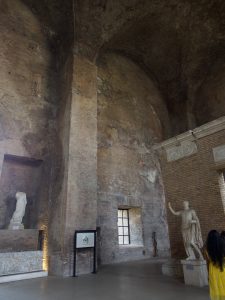
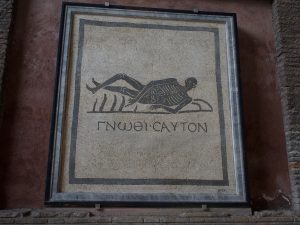
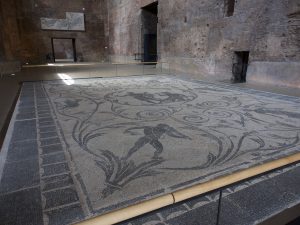
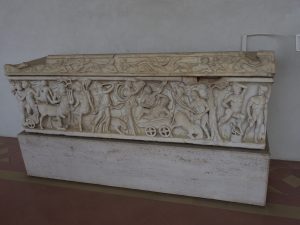
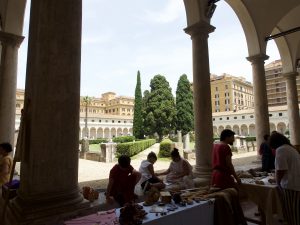
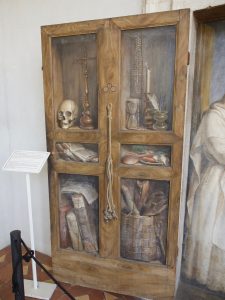
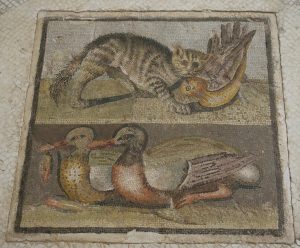
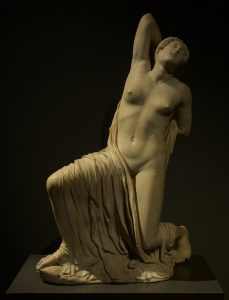
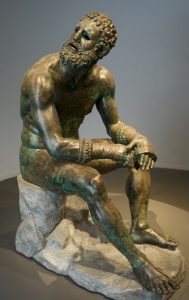
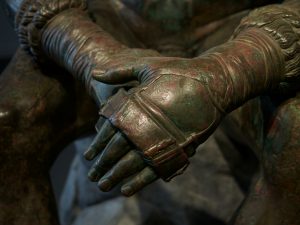
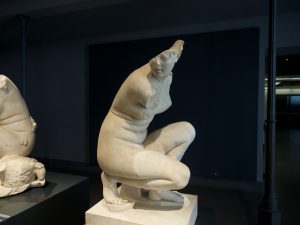
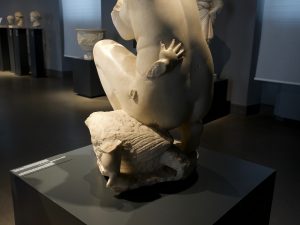
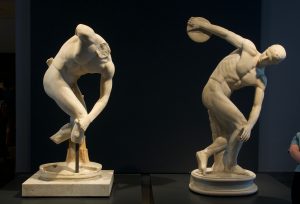
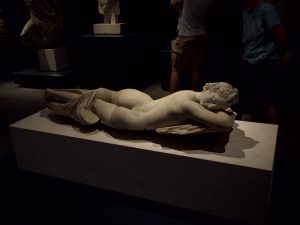
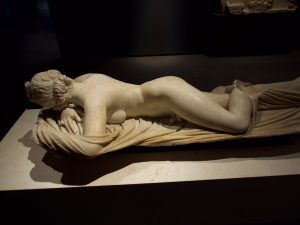
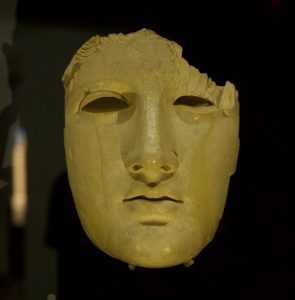
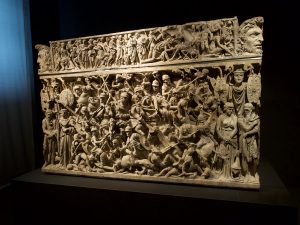
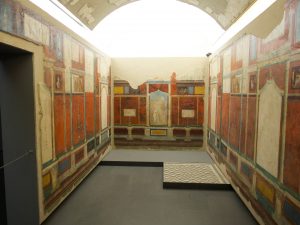
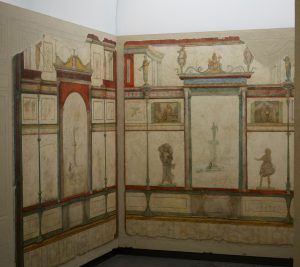
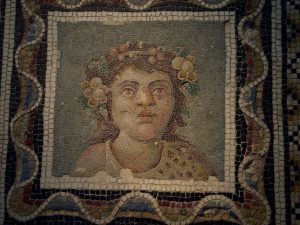
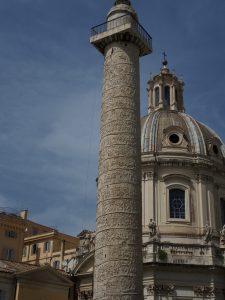
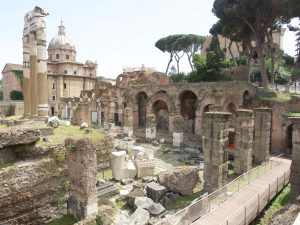
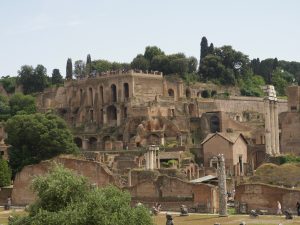
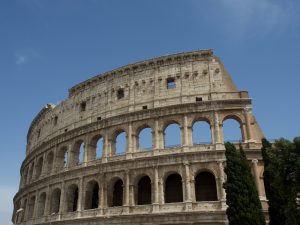
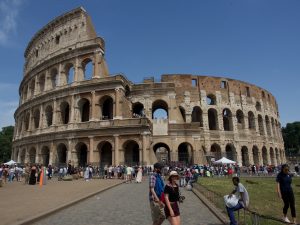
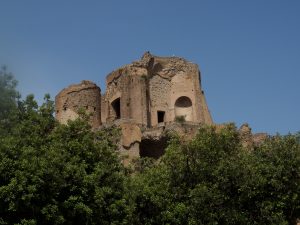
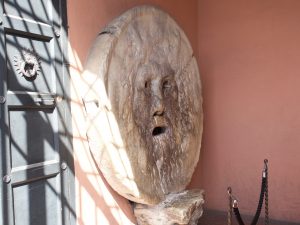
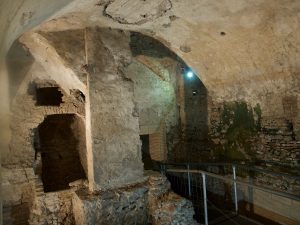
We woke up a little early and puttered around longer than usual, because breakfast at this guest house (very modern rooms in what I think are two converted apartments, again in a building with a concierge but also with heavy metal gates and all kinds of „keep out“ signals) didn’t start until 8. We had croissants and coffee/tea, and then took off across the Tiber and into the northern part of Rome’s downtown that we didn’t explore on our first 3-day stay. We walked to the enormous & ugly be-obelisked piazza del Popolo to the Spanish steps, and dutifully walked up them—which was still possible because it was a little early for the hundreds of tourists who usually sit there just to sit there. We then made our way to my two „must-see“ churches for the day (I thought I was really „done“ with churches and looking specifically for Renaissance buildings and art works for now, because I feel I have done justice to my research project, and it’ll be about Florence only, anyway, but we ended up in a whole bunch of them, anyway): S. Maria Vittoria and S. Carlo alle Quattro Fontane.
The first, a totally overwrought baroque church with all the gold and inlaid marble and over-top twirls and swirls one could wish for (or not, in my case) was on the list because Bernini’s famous statue of Saint Teresa of Avila is there. She is presented with an angel descending and a bunch of divine gold rays behind her, cleverly lighted, and in a state of ecstasy that has looked to many viewers like she is having an orgasm ever since the statue was erected. George Eliot and Anna Jameson did not like that statue! But I do, precisely because this is such eroticized religious iconography, and I am planning to write about the reception of this statue for my Baroque seminar in the fall if I can swing it.
My second bucket-list church, S. Carlo, was also baroque, and one of the most interesting churches in my Art History survey. It is famous as a church designed for a weird corner space with two facades, by Bernini‘s enemy/rival Borrimini, with super unusual curves and an oval cupola covered in the weirdest-shaped coffers ever. Even though it is not heavily decorated in gold and paintings like so many later baroque churches, it gives up basically all straight lines (except downward) for curves. There are even some curved versions of pediments. Bizarre and wonderful and, at the time he designed it, without any precedent. I am still sad I didn‘t get to see his other famous church, S. Ivo, from the inside, but one can‘t have everything. We even got to talk to an architectural historian who was setting up photogrammetry equipment to get a 3-D image of the entire church assembled.
At this point, it turned out to be a lie that we were now „done“ with churches, because by now I‘d discovered that the best Roman ruins to visit in the vicinity of these two churches would be the Baths of Diocletian, which I did not see on my previous visit to Rome at all, and knew very little about. It turned out that the very first thing we saw of them was S. Maria degli Angeli e Martiri, the church that, based on ideas by Michelangelo, was built right inside of the not-very-ruined part of the baths that used to be the frigidarium. The outside is just the Roman structure; the inside is an enormous Greek Cross design with a sort of extension to almost make it a Latin cross, but not twice. It is huge, because it uses the entire height of the Roman vaults that were already there (28 meters), and it also has a surprise extra science feature—a meridian line in the floor, with a little hole for the sun to shine on a different point on it every day at the solar noon. We didn‘t stay for this, but we still thought that was very cool.
From there, we went into the actual Baths of Diocletian, which are mind-boggling in terms of size. Public baths for 3000 people—that‘s basically a water park from the 3rd century. The museum has an exhausting number of exhibits on Roman history and a display of tons of things found here and elsewhere in Rome—grave markers, sarcophagi, statues (including a sleeping nymph that made the connection to the Sleeping Ariadne type pretty clear), mosaics, etc, arranged partly in a brand new structure, partly in a couple of former cloisters (also designed by Michelangelo?)—but what makes it most impressive is that you can walk around in several of the former bath halls and see the size and the structural features really well. They are so big that smaller Roman structures from elsewhere, like a small temple and two tufa tombs, have been moved into them for display. Pretty incredible—I especially liked a moralizing mosaic, a skeleton with „Know thyself“ in Greek above, which came from some early Christian site and was displayed in the big hall. There were also a whole bunch of re-enactors showing different Roman crafts and trades, which was a fun side show—for the rather limited number of people who were at the museum, which in any other city would be awe-inspiring, and here is just a minor site museum—we got combo tickets for 4 different antiquity museums for 12 Euro a ticket, which was an amazing bang for the buck, as it turns out—while everyone goes to the Forum and the Capitoline Museum.
After our visit to the Baths (actual water would have been nice, though! It was SO HOT already), we found the next museum, the Palazzo Massimo, across the piazza from the entrance, complete with a museum cafe, where we had a very reasonable lunch (panini for 2 with a pastry and a bottle of water each, for less than 15 euro), now ready for more antiquities. And antiquities there were. Wow. So much to see!
First of all, their prize displays are several actual Greek sculptures, which are of course incredibly rare to have survived. There was an amazing half-naked Dying Niobid which I had come across because she was the subject of a „trick question“ on my Greek sculpture exam. She is much older than any free-standing naked female sculpture I had previously known about (440-430 BC, earlier by far than the famed Aphrodite of Knidos that was a titillating sensation in the 4th century, but didn‘t survive in an original). I still want to find out more about her some day. For now, I was just thrilled to see her beautifully displayed in her graceful pose (dying? Oh well, very idealized dying). So much more impressive than the Niobids in the Uffizi…
Then there was also the Boxer at Rest, a gorgeous Hellenistic bronze that I didn‘t know I would find here, with amazing detail: the cauliflower ears, the punched-in nose, the cuts and bruises, and with his gloves still on. He looks so worn out and unhappy—but what amazing artistic care went into making that come out in the pose and the details. I didn‘t realize that he was found in Rome in the late 20th century, buried during late Roman times to avoid being destroyed by one oncoming invader or another—there was an amazing photo with him just crouching in a corner of a staircase after they had unearthed him.
There were also many Roman copies of Greek works, of course, a whole hall full—but this time around, without the Renaissance and Baroque additions and improvements. We saw two beautiful Crouching Aphrodites (popular in baths, since she‘s supposed be coming out of the bath), and 2 copies of Myron‘s lost Diskobolos, the disk thrower, arranged in parallel, one almost complete. But my favorite was a sleeping hermaphrodite, this time with space to walk all the way around it and get the non-binary gender surprise once you see his/her front. Of course, the face is also supposed to tip us off, somewhere between pubescent boy and young woman, but the „trick“ is really pretty good.
Among the „further ran“ were TONS of Roman portraits and a really creepy-looking but amazing display involved the ivory face / mask of a statue that was recovered along with many other bits and pieces of the same statue from an illegal excavation / antiquities theft operation. There were also several late, super-crowded sarcophagi, including the ENORMOUS Portonaccio sarcophagus with all its actions, and some late sculptures from the time of Septimius Severus, where you can really see the transition to medieval art in late Imperial Rome—the stiff postures, the frontal position, the refusal to show either emotion or dynamic action because showing the inside, the “soul,” of people on the outside becomes less and less interesting in evolving Christian-influenced art, culture, and philosophy.
AND THEN there was a whole floor dedicated to mosaics and wall paintings from sites all over Rome, especially from the Roman villa on the banks of the Tiber discovered on the grounds of the Villa Farnesina. These were displayed room by room—bedrooms, hallways, a „winter dining room“ (in black with light-colored paint, on the recommendation of Vitruvius himself), all with incredible detail and color; in so-called “fourth style,” but with a lot of variations on what I learned about that in my survey class. The most beautiful mosaics was a head of Bacchus that looked a lot like the head of Caravaggio‘s Boy Bacchus.
We left after a couple of hours, and decided to keep walking on the tracks of the ancient Romans (which meant abandoning the option of going into the Borghese gardens). Fortified by gelato, we walked toward the imperial Fori, including Trajan’s column, and yet another let’s-just-use-the-ruins-for-our-purposes church (S. Damian and Cosmas, maybe?), until we got to the outskirts of THE Forum, where you can see quite a bit from the outside looking in, which was good enough for us. Everywhere you turned, there were so many layers of architecture, especially when looking down into the actual forum. There were also lots of people, including lots of very aggressive vendors, but not as many as at the Colosseum. Mark got some standard postcard shots, but then also some with the crowds everywhere on the plaza by the Colosseum. We then walked past the Circus Maximus, with the huge ruins of another basilica on the other side.
We walked past the Bocca della Verita, the Mouth of Truth, famous from Roman Holiday and still a big tourist draw (again, we took a photo from the outside rather than lining up to have our turn at putting our hands in the mouth and pretend to get it bitten off). It’s entertaining to think that it might have been a drain cover in the little round Roman temple across from it in a teeny park. Little did they know back then that it would become this big arbitrary tourist attraction… Our goal was the Baldi Crypta Museum — yet another site museum, which turned out to be a fascinating ramble through basement-level Roman excavations of a 1st-century crypta (some of which became a Roman latrine at some point) underneath what then became medieval housing and ultimately a palazzo . They were a bit hard to photograph, and the documentation wasn‘t always as clear as we would have liked, but it was still interesting.
By now it was 6 pm and we had been walking all day (we tracked over 12 miles total for the day!). We decided to head home, which led us past the completely overcrowded plaza by the Pantheon (we were glad we went when we did 10 days ago, at a less crowded time!), and along the Tiber until we got to yesterday‘s restaurant. We had pizza, bruschetta and salad, and glorious gelato at the gelateria that Rebecca had introduced us to. Then we went home, very sticky and rather tired, so we decided to not go back out in the evening but have showers, look through today’s crop of photos, and go to sleep a little earlier than usual. Rome is so enormous that we have to have “the courage to leave things out“ (the German phrase is perfect, we need “Mut zur Lücke,” = “courage for the gap”). So we‘ll see what we can still see tomorrow and then call it good.